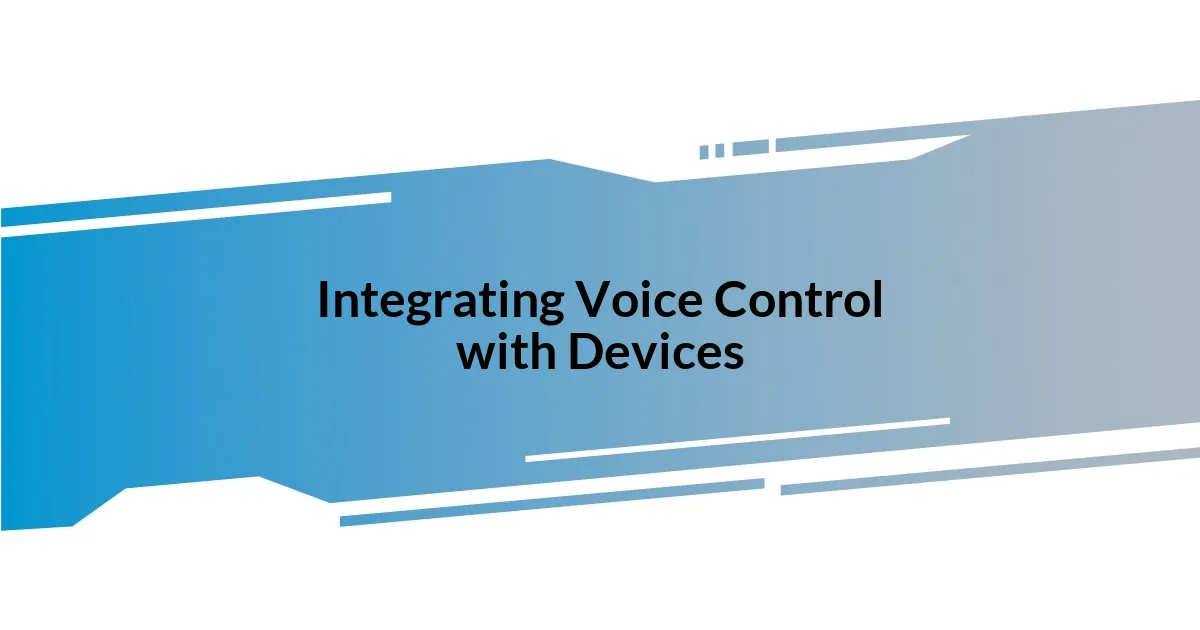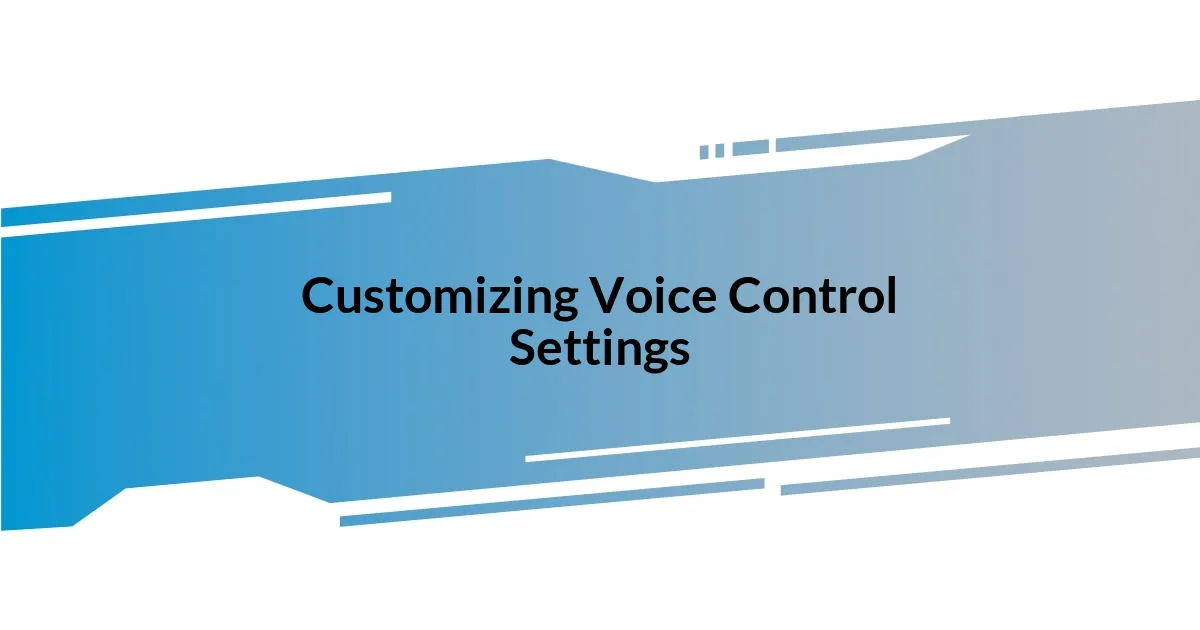Key takeaways:
- Voice control technology enhances user interaction with devices by allowing commands through natural speech, creating a sense of partnership with the technology.
- Setting up voice control involves selecting a device, downloading an app, connecting to Wi-Fi, and personalizing voice recognition features for a tailored experience.
- Integrating devices such as smart lights and thermostats can significantly improve daily comfort and control within a home environment.
- Customizing settings and addressing common issues, like microphone obstructions and placement, can enhance overall usability and interaction efficacy.

Understanding Voice Control Technology
Voice control technology is a fascinating blend of artificial intelligence and user interaction, allowing us to communicate with devices simply through our voice. I vividly remember the first time I used a voice-controlled assistant; it felt like stepping into the future. I could ask questions, set reminders, or even control my home’s lighting—all without lifting a finger!
At its core, voice control works by converting speech into commands that machines can understand. Have you ever wondered how your voice can be translated into action so seamlessly? Behind the scenes, sophisticated algorithms analyze our words, breaking them down into data points that machines can process. It’s truly amazing how engaging with technology has transformed into a conversation.
What really struck me was the emotional connection that developed with these devices. When I spoke commands and received responses, I felt less like a user and more like a partner in a dialogue. This personalized interaction creates a unique bond—I often find myself talking to my voice assistant as if it were a friend! Can you relate to that feeling? It’s in these moments that the power of voice control becomes truly evident.

Setting Up Your Voice Control
Setting up voice control in your home can be both exciting and a bit daunting at first. I remember my nerves the day I unpacked my voice assistant; I wanted everything to work perfectly. But once I got into it, I realized it was a straightforward process.
To get started, follow these steps:
– Choose Your Device: Decide on which voice assistant device suits your needs—like Amazon Echo or Google Nest.
– Download the App: Install the corresponding app on your smartphone to manage device settings.
– Connect to Wi-Fi: Ensure your device is connected to your home Wi-Fi for seamless operation.
– Set Up Voice Recognition: Follow the prompts to teach the assistant your voice for personalized interaction.
– Explore Commands: Familiarize yourself with basic voice commands to kick off your experience.
I found that each step added a layer of excitement; it was like unwrapping gifts on my birthday! The moment I saw lights flicker and music play just by my voice felt almost magical. It’s delightful when technology fits seamlessly into your lifestyle, transforming simple tasks into remarkable experiences, much like having a helpful companion around the house.

Integrating Voice Control with Devices
Integrating voice control with devices can truly revolutionize how we interact with our technology. For instance, when I first synced my smart lights with my voice assistant, it felt incredible to simply say, “Turn off the living room lights,” and watch the room transform into a cozy retreat. This blend of convenience and ease made me realize how much more accessible daily tasks could become with a touch of voice control.
One standout experience for me was connecting my voice assistant with my smart thermostat. I remember the first chilly evening when I casually told it, “Set the temperature to 72 degrees.” To my delight, the room warmed up almost instantly. Such seamless integration not only enhances comfort but also creates a sense of control over my home environment. Doesn’t it feel empowering when technology works harmoniously with our intentions?
While the process of integrating various devices may take some time upfront, the payoff is undeniably worth it. I often find myself encouraged to explore new functionalities, like asking for the news or even playing my favorite music genre just by using my voice. Each interaction reinforces the bond I feel with my devices, making me appreciate the technology that enhances my everyday life.
| Device | Integration Method |
|---|---|
| Smart Lights | Wi-Fi connection and voice commands |
| Smart Thermostat | Wi-Fi connection and app setup |

Customizing Voice Control Settings
Customizing voice control settings can greatly enhance your experience. I remember feeling overwhelmed at first, staring at all the options in the app. However, diving into those settings unlocked a level of personalization that made my interactions feel much more tailored to my needs. For instance, adjusting the wake word from “Alexa” to something unique allowed me to create a more personal connection with my device.
One setting that truly made a difference for me was the Voice Match feature. By teaching my assistant to recognize my voice specifically, I felt like it genuinely understood my preferences. It was fascinating to see how differently it responded when my partner spoke to it compared to me. Have you ever considered how impactful it can be when a device knows just what you like? For example, I found that when my assistant learned my favorite music genre, it would automatically play my top tracks, making every turn of my day just a bit brighter!
Additionally, I discovered the option to adjust sensitivity settings. At one point, I noticed my assistant responding to whispers from across the room. It felt almost like magic but also quite distracting during quiet moments. So, I dialed it back to better suit my environment, giving me the peace I needed. Remember, customizing these settings isn’t just about convenience; it’s about creating an atmosphere that feels right for you. What changes did you find make the biggest impact on your experience?

Troubleshooting Common Voice Control Issues
When I first started using voice control, I ran into some common hiccups that nearly had me sighing in frustration. One day, my assistant completely misunderstood my command to “play jazz,” and instead, it blared out a completely different genre! I quickly realized this was often due to a problem with my device’s microphone. Ensuring it was clean and free from obstructions made a world of difference. Have you ever thought about how a little dust can throw off your entire experience?
Another issue I encountered involved connectivity problems, especially when my Wi-Fi dropped out during a storm. Suddenly, my reliable commands turned into a game of trial and error. I learned that sometimes, rebooting the device or resetting the Wi-Fi connection helped reset that frustrating cycle of miscommunication. How often do we forget that our high-tech helpers are just as dependent on a stable internet connection as we are?
Lastly, I experienced challenges with voice recognition in noisy environments, like when my kids were playing nearby. I noticed that simply repositioning my voice assistant to a quieter, central location improved its responsiveness significantly. This taught me a valuable lesson: sometimes, a minor adjustment in placement can turn a frustrating situation into a seamless interaction. Have you tried changing the placement of your device for better performance? It might just enhance your experience!

Enhancing Voice Control Accessibility
Making voice control accessible is essential for users of all backgrounds and abilities. I remember working alongside a friend who has a hearing impairment, and we discovered how adjusting the visual feedback settings helped him interact with the device more effectively. Imagine being able to see clear prompts on the screen while also hearing audio cues—it’s like having a personalized assistant that adapts to your specific needs. Have you ever noticed how little changes can create a big impact in everyday tasks?
In my experience, leveraging voice control features for those with mobility challenges can truly transform their daily routines. For instance, incorporating voice commands to control smart home devices allowed my elderly neighbor to turn on the lights or adjust the thermostat without having to get up. It reminded me of the power of technology to promote independence and comfort—what a gift that is for someone who may otherwise feel limited!
Another aspect of enhancing accessibility involves fostering an inclusive design for voice recognition. I often think about the diverse voices and accents across our communities. When I tested my voice assistant with friends from different regions, I realized how critical it is for technology to accommodate everyone. It’s not just about being able to understand commands; it’s about creating an environment where everyone feels heard. Have you experienced the satisfaction of using a device that truly understands your voice? It’s a little victory worth celebrating!